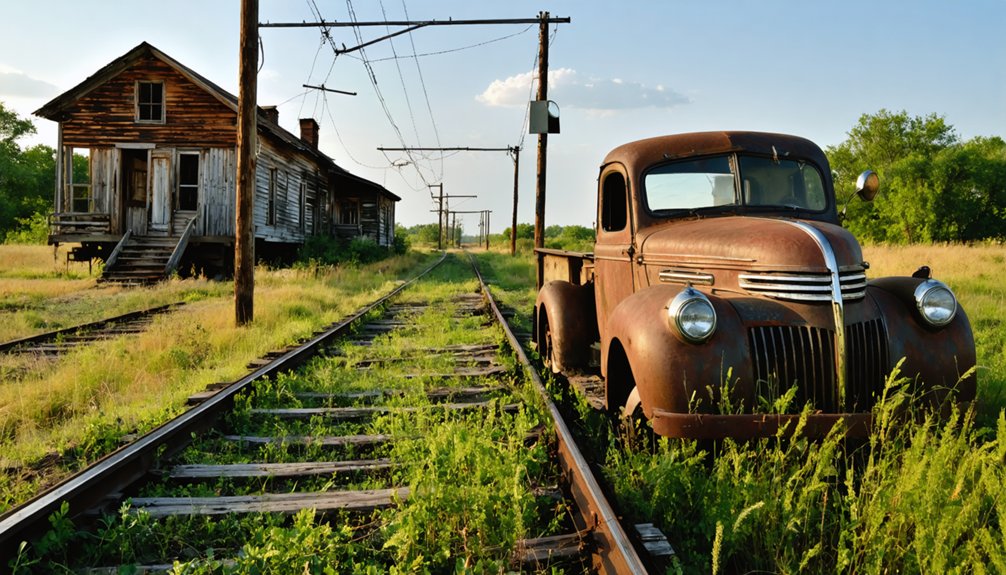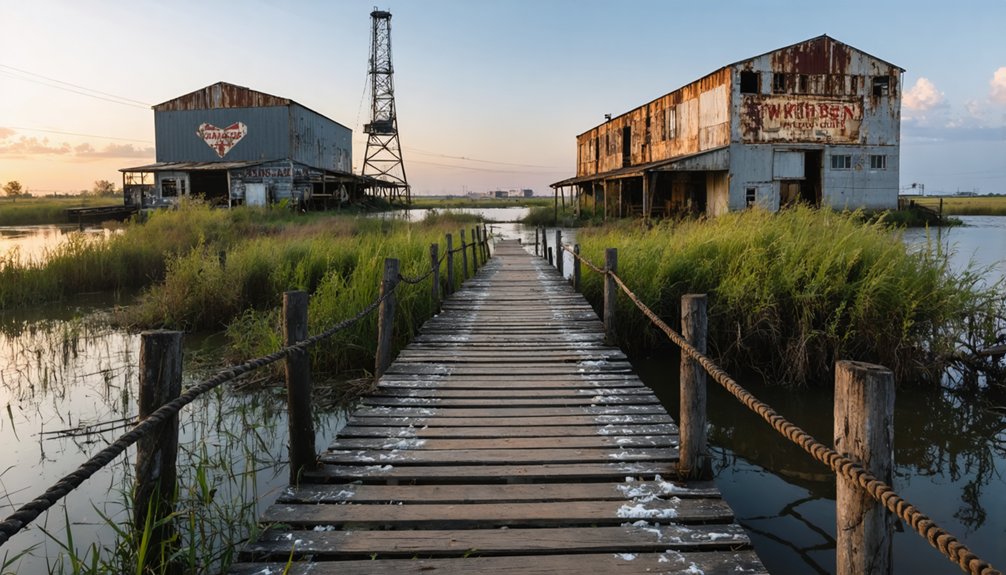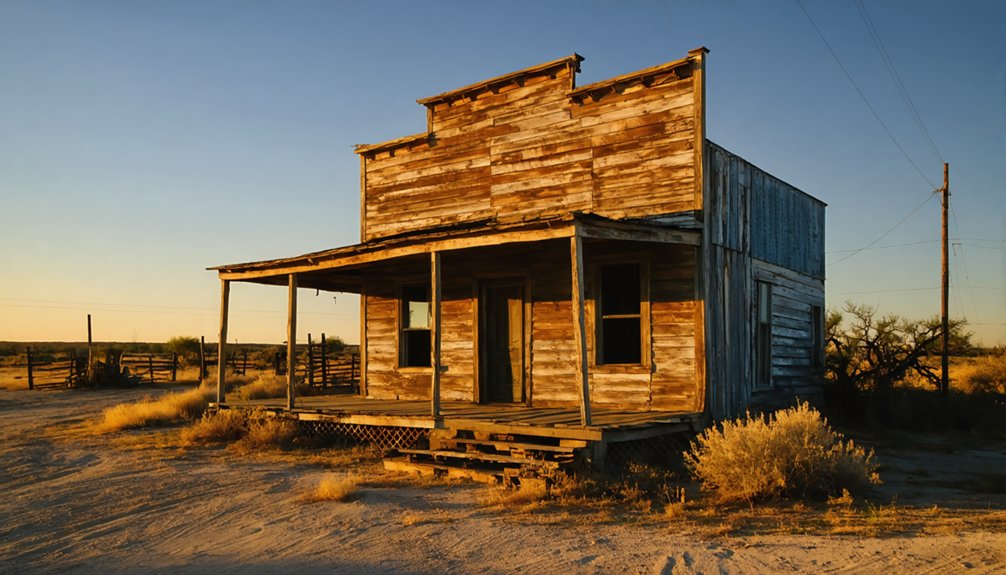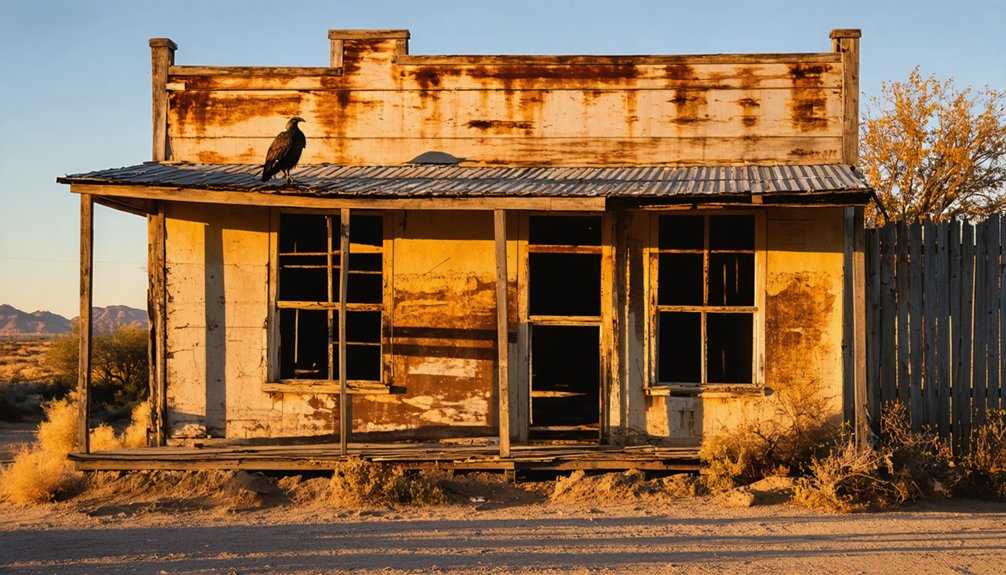You’ll find Wild Cat Bluff along the Trinity River in Anderson County, Texas, where a bustling river settlement once thrived in the 1840s. This strategic crossing point served as an essential hub for steamboats and ferries transporting cotton, livestock, and settlers between Houston and Galveston. The town’s prosperity declined in the 1870s when railroads became the dominant transportation mode. Today, preserved wagon ruts and ferry landing remnants tell compelling stories of this forgotten Texas ghost town.
Key Takeaways
- Wild Cat Bluff was a vital Trinity River crossing point in 1840s Texas, serving steamboats and ferry operations for regional commerce.
- The settlement thrived as an agricultural hub, shipping cotton and agricultural products to Houston and Galveston via river transport.
- Decline began in the 1870s when railroad expansion diminished the importance of river transport and traditional stagecoach routes.
- Archaeological remnants include ferry landing sites, wagon trail ruts, and foundations of the former river port settlement.
- The ghost town now functions as a heritage tourism site featuring guided tours, historical reenactments, and preserved structural remains.
The Rise of a River Town
Along the banks of the Trinity River in northwestern Anderson County, Wild Cat Bluff emerged as an essential river crossing in the 1840s.
Located at the confluence of Wildcat Creek and the Trinity, you’d find a bustling hub where steamboats and flat-bottom sternwheelers carried goods and passengers from the Gulf of Mexico all the way to Dallas.
The town’s ferry operations played an important role in regional commerce, enabling farmers, travelers, and livestock to cross the Trinity with ease.
As river navigation dominated transportation in mid-19th century Texas, Wild Cat Bluff’s strategic location transformed it into a thriving commercial center.
You could witness the constant flow of agricultural products being loaded onto vessels, while the ferry service connected communities on both sides of the river, establishing the town as a key player in East Texas trade. The settlement grew to include a post office and saloon, making it a proper town by 1859.
The town’s prosperity would eventually decline when the railroad expansion redirected trade routes in the 1870s.
Life at the Crossroads of Water and Commerce
Life in Wild Cat Bluff centered on the dynamic rhythm of river commerce, where daily activities revolved around the ferry operations and steady flow of goods across the Trinity River.
You’d find residents bustling around the river ferry, helping merchants load agricultural products onto boats while travelers waited their turn to cross. The community dynamics were shaped by nature’s schedule – seasonal river conditions determined when you could ship goods or operate the ferry.
If you’d visited Wild Cat Bluff then, you’d have seen a tight-knit community adapting to life at this vital intersection. The area became part of the historic Frying Pan Ranch when Joseph S. Glidden purchased over 60,000 acres in 1881.
Local businesses served travelers and traders, while residents maintained the ferry systems and provided essential services. Your success in this river town depended on understanding both the water’s rhythms and the steady parade of commerce passing through. Early cowboys named the area for the wild cats that made their home beneath the prominent bluff.
Agricultural Heritage and Trade Routes
You’ll find Wild Cat Bluff‘s rich agricultural story woven into West Amarillo Creek’s once-flowing waters, where early settlers established a vibrant farming community centered on cotton production and livestock.
The town’s position along a branch of the Santa Fe Trail made it a natural hub for agricultural trade, with nearby cotton gins and processing facilities serving multiple farming families. Regular stagecoach service operated on Tuesdays and Thursdays, facilitating commerce and communication between Wild Cat Bluff and neighboring communities. The area remained Indian territory for centuries before white settlers arrived to farm the land.
The proximity to water routes and established trade paths helped Wild Cat Bluff’s farmers transport their cotton, grains, and livestock to regional markets until the mid-20th century’s technological changes altered traditional farming methods.
River Trade Networks
Situated at the strategic confluence of Wildcat Creek and the Trinity River, Wild Cat Bluff emerged as an essential hub in Texas’s 19th-century river trade network.
You’d find bustling ferry crossings and shipping points where local farmers and ranchers moved their agricultural products downstream. The Trinity River’s trade dynamics connected interior communities with broader markets, while nearby branches of the Santa Fe Trail provided complementary overland routes.
Before the railroad’s arrival in 1870, river navigation was your lifeline to economic opportunity. You could transport cotton, grain, livestock, and other goods from your farm through Wild Cat Bluff’s river landing.
The settlement’s strategic location supported not just goods movement but also fostered secondary enterprises like cotton ginning and distilling, creating a self-reliant trading community along the Trinity’s crucial corridor.
Farming Communities Unite
While early settlers established Wild Cat Bluff in the 1840s, the region’s true agricultural identity emerged through the collective efforts of farming families working the land.
You’ll find evidence of community resilience in how these frontier farmers joined forces, sharing resources and labor to survive harsh conditions. Cooperative farming flourished as neighbors maintained common water sources and gathered for shared tasks. The community’s prosperity grew with the addition of a dry-goods store and other essential businesses. The area’s once-thriving ecosystem supported clear flowing water that sustained both agriculture and recreation.
Key elements of their unified approach included:
- Joint maintenance of irrigation systems along West Amarillo Creek
- Shared facilities including a community dancefloor and fishing hole
- Collaborative management of grazing lands, particularly at Frying Pan Ranch
The introduction of essential infrastructure, like the 1963 windmill installation, further strengthened these bonds as families worked together to sustain their cattle operations and crop cultivation.
Cotton Transport Hub
Beyond its farming community bonds, Wild Cat Bluff emerged as a major cotton transport hub along the Brazos River in the 19th century.
You’ll find its strategic location made it essential for cotton production throughout the Middle Brazos valley, where steamboats collected and transported countless bales to markets in Galveston and New Orleans.
Before railroads dominated Texas transport, river navigation was your lifeline to economic freedom.
Wild Cat Bluff’s warehouses and loading facilities helped you store and ship cotton downstream, connecting your harvest to international markets.
During the Civil War, you’d have witnessed creative solutions to maintain cotton shipments despite Union blockades.
Large merchant vessels loaded cotton shipments at Gulf ports for export to distant harbors, extending Wild Cat Bluff’s trade reach.
While the town’s importance eventually faded with the rise of rail transport, Wild Cat Bluff’s legacy lives on as a symbol of Texas’s dynamic cotton trade history.
The crop-lien system kept many local farmers in perpetual debt to landowners through high-interest commissary purchases.
Transportation Evolution and Its Impact

Throughout its history, Wild Cat Bluff’s transportation evolution reflected the dramatic shifts in how Texans moved people and goods across the frontier.
Wild Cat Bluff stood witness to Texas’s evolving frontier, as changing transportation methods reshaped how people and cargo moved across the land.
You’ll find evidence of these transportation transformations in:
- The steamboat landing that once welcomed flat-bottomed sternwheelers from the Gulf of Mexico
- The enduring Wildcat Ferry operation that served river crossings for nearly a century
- The historic wagon ruts still visible from the Santa Fe Trail branch that crossed through the area
When railroads emerged as the dominant mode of transport, they bypassed Wild Cat Bluff, triggering the ghost town evolution we see today.
The site’s strategic position along early stagecoach routes and cattle drive paths couldn’t save it from decline once the iron horse changed how Texans traveled and shipped their goods.
Daily Life in Wild Cat Bluff
If you’d lived in Wild Cat Bluff during its heyday, you’d have spent your days around the bustling riverfront where farmers loaded their goods onto boats and travelers waited for ferry crossings.
Your social life would’ve centered around the town’s natural gathering spots, including the popular dance floor by Wildcat Creek where community events regularly took place during summer months.
Your family’s home, likely a simple cabin or ranch house near the riverbank, would’ve provided easy access to both the trading activities and recreational opportunities along the Trinity River.
River Trade Activities
When steamboats first navigated the Trinity River to Wild Cat Bluff in the mid-19th century, they transformed this Texas settlement into a bustling river trade hub.
You’d find flat-bottomed sternwheelers docking regularly, connecting the Gulf of Mexico to settlements near Dallas while carrying essential supplies and livestock.
The river trade supported local economies in three key ways:
- Ranchers transported cattle and sheep to larger markets
- Farmers shipped their harvests downstream
- Merchants received goods necessary for settlers’ daily life
As railroads expanded across Texas, Wild Cat Bluff’s economy shifted through economic adaptation.
While steamboat traffic declined, the Wildcat Ferry maintained river crossings for nearly a century, operating about two miles north of where the U.S. Highway 287 bridge now stands between Palestine and Corsicana.
Community Gathering Places
Despite its small size, Wild Cat Bluff fostered a vibrant community life centered around several key gathering places.
West Amarillo Creek served as a natural hub where you’d find locals enjoying communal swimming during scorching Texas summers. A dance floor near the creek became the heart of summer parties and social interaction.
The ferry crossing wasn’t just for transportation – it doubled as a meeting spot where farmers, merchants, and travelers exchanged news and goods.
The Visitors Center, originally a ranch house, represented the town’s rustic structures where families gathered for various occasions.
You’d likely find residents congregating at the shipping point, where daily trade activities created opportunities for socializing while loading and unloading riverboats.
Family Living Conditions
Life in Wild Cat Bluff revolved around simple wooden homes nestled along the Trinity River and Wildcat Creek. You’d find these early family structures built from local timber, typically consisting of one or two rooms with basic dirt or wooden floors.
As shelter evolution progressed, homes began incorporating windows and chimneys by the mid-1800s.
Daily survival depended on your family’s ability to maintain self-sufficiency through:
- Growing crops like corn and beans in nearby garden plots
- Raising livestock for meat, milk, and eggs
- Drawing water from creeks or windmill-powered wells
You’d spend your days sharing labor with family members, from tending crops to crafting essential items.
Children pitched in by gathering firewood and helping with chores, while adults managed farming, animal husbandry, and home maintenance tasks.
Natural Features and Geographic Significance
Located at a critical junction in northwestern Anderson County, Texas, Wild Cat Bluff sits where Wildcat Creek meets the Trinity River.
You’ll find diverse natural habitats spanning over 650 acres of native prairie, grasslands, and riparian zones around the former townsite. The area’s geological features include dramatic bluffs carved by water erosion, rolling hills, and exposed sedimentary rock formations that tell the story of the region’s natural history.
The terrain’s strategic position at this river crossing point made it ideal for early transportation and commerce. The Trinity River served as an essential waterway before railroads, while the surrounding soil supported agriculture.
Today, you can explore trails that wind through small canyons and prairie landscapes, showcasing the mixed-grass ecosystems and native plant communities that define this distinctive Texas landscape.
The Decline of River Commerce

As railroads revolutionized Texas transportation in the late 19th century, Wildcat Bluff’s once-bustling river commerce began a steady decline.
You’ll find evidence of this economic change in the abandoned riverfront businesses and forgotten steamboat landings that once made this settlement thrive.
The shift from river transportation to rail brought three major changes to Wildcat Bluff:
- Local businesses, including dry-goods stores and blacksmith shops, closed as trade moved to rail hubs.
- The community’s focus shifted from river-based commerce to agriculture and ranching.
- The post office and commercial district shrank as nearby rail towns like Cayuga grew in prominence.
Though the ferry continued operating for local transport, Wildcat Bluff’s strategic importance faded, transforming it from a vibrant trade center into a quiet rural settlement.
Legacy in Anderson County
You’ll find Wild Cat Bluff‘s most enduring legacy in its role as Anderson County’s essential transportation hub, where the convergence of Wildcat Creek and Trinity River supported regional commerce through ferry crossings and steamboat traffic.
The site’s agricultural significance shaped early settlement patterns, with surrounding farmland yielding productive cotton and corn harvests that sustained the local economy.
The bluff’s strategic location near the Trinity River helped establish key trade routes for Anderson County’s farmers, who relied on river transport to move their goods to market until railroad development in the 1870s shifted commerce eastward.
Historical Transportation Hub Legacy
While the railroads ultimately led to its decline, Wild Cat Bluff‘s strategic position at the confluence of Wildcat Creek and the Trinity River established it as Anderson County’s premier transportation hub during the mid-1800s.
The site exemplifies the dramatic transportation shifts that shaped Texas frontier development, from waterway dominance to rail supremacy.
You’ll find Wild Cat Bluff’s river economies were built on three crucial functions:
- Operating as a crucial ferry crossing point
- Serving as a shipping center for northwestern Anderson County farmers
- Connecting rural communities through Trinity River commerce
Today, the ghost town stands as a reflection of how technological progress can reshape communities.
What was once a bustling river port now serves as a historical marker of Anderson County’s evolving infrastructure, reflecting broader patterns of transportation development across Texas.
Agricultural Commerce Impact
Beyond its role as a transportation center, Wild Cat Bluff anchored Anderson County’s rich agricultural heritage through the late 1800s and early 1900s.
You’ll find evidence of remarkable crop diversity, with the area’s fertile soil yielding 500 pounds of cotton per acre and 30 bushels of corn. Local farmers embraced agricultural innovations through county demonstration agents who introduced modern farming methods and crop sustainability practices.
The region’s bounty extended beyond traditional crops, featuring abundant wild berries, plums, and native pecan trees that produced thousands of pounds of nuts annually.
While cotton dominated commerce with 300,000 pounds shipped to Galveston and Houston markets, the area’s agricultural success also relied on expert-led soil conservation efforts and strategic government programs supporting livestock and crop management.
Today’s Wildcat Bluff preserves this legacy through its historic ranch house and enduring agricultural infrastructure.
Early Settlement Patterns
Situated at the essential confluence of Wildcat Creek and the Trinity River, Wild Cat Bluff emerged as a critical settlement hub in northwestern Anderson County during the mid-1800s. Settler motivations centered on the area’s strategic location and fertile soil, which supported thriving agricultural enterprises.
The community dynamics at Wild Cat Bluff were shaped by three key factors:
- Access to navigable waterways that enabled seasonal steamer traffic to Houston and Galveston
- Proximity to productive farmland yielding cotton and corn crops
- Position along crucial migration routes with established ferry crossings
You’ll find that Wild Cat Bluff’s significance gradually declined as railroad towns gained prominence after 1870, though its legacy lives on in Anderson County’s early road networks and settlement patterns that shaped the region’s development.
Archaeological Remnants and Physical Traces
Although time has erased much of Wild Cat Bluff‘s original settlement, significant archaeological evidence remains scattered across this historic Texas site.
You’ll find archaeological findings along the Trinity River, including remnants of ferry landings and possible river port foundations that once served as crucial shipping points. Historical artifacts from both Native American and early Texan settlers dot the landscape, with preserved wagon ruts from the Santa Fe Trail still visible in the terrain.
As you explore the 7-mile trail system, you’ll encounter interpretive signage marking Comanche hunting grounds and early ranch sites.
The Gilvin Science Education Building houses an impressive collection of local specimens, from fossils to preserved wildlife, while stone tools and mammal bones discovered in the area provide tangible connections to the region’s past.
Ghost Town Tourism and Historical Preservation

While many Texas ghost towns have faded into obscurity, Wild Cat Bluff has emerged as a notable heritage tourism destination that draws thousands of visitors annually.
Defying the fate of forgotten frontier settlements, Wild Cat Bluff stands as Texas’s premier ghost town, attracting history seekers year-round.
The town’s ghost town preservation efforts focus on maintaining authentic structures while guaranteeing visitor safety and educational value.
You’ll find three main tourism draws at Wild Cat Bluff:
- Guided historical tours led by local experts who share stories of the town’s boom-and-bust past
- A restored mercantile building that now serves as a visitor center and museum
- Special events featuring period reenactments and photography workshops
The tourism impact has revitalized nearby communities, with local businesses benefiting from increased visitor traffic.
A partnership between the county historical society and preservation groups guarantees ongoing maintenance while protecting the site’s cultural significance through interpretive programs and careful conservation practices.
Frequently Asked Questions
Were Any Notable Crimes or Outlaws Associated With Wild Cat Bluff?
You’ll find no documented outlaw legends or specific crime stories tied directly to Wild Cat Bluff, though the area experienced broader regional violence during the Lee-Peacock Feud and Reconstruction era.
What Native American Tribes Originally Inhabited the Wild Cat Bluff Area?
You’ll find the Tonkawas, Comanches, and Lipan Apaches dominated the tribal history around Wild Cat Bluff, with each group leaving their cultural significance through buffalo hunting and strategic use of the terrain.
Did Any Famous Historical Figures Ever Visit Wild Cat Bluff?
You won’t find records of famous visitors to this spot, as Wild Cat Bluff’s historical significance centered on being a Trinity River ferry crossing and shipping point rather than attracting notable figures.
What Was the Maximum Recorded Population of Wild Cat Bluff?
Like a flickering flame before darkness, you’d have found Wild Cat Bluff at its brightest with a maximum population of 150 residents in 1892, before dwindling into the ghost town it became.
Were There Any Schools or Churches Established in Wild Cat Bluff?
You won’t find documented school history or church significance in Wild Cat Bluff’s records. Given its brief prominence as a shipping point, it’s unlikely formal educational or religious institutions were established.
References
- https://en.wikipedia.org/wiki/Wild_Cat_Bluff
- https://mix941kmxj.com/shot-of-the-century-legacy-of-forgotten-panhandle-town-revisited/
- https://kids.kiddle.co/Wild_Cat_Bluff
- https://discoverycentercollective.org/the-history-of-wildcat-bluff/
- https://knue.com/texas-gulf-ghost-town-indianola/
- https://en.wikipedia.org/wiki/List_of_ghost_towns_in_Texas
- https://www.texasescapes.com/CentralTexasTownsSouth/Bluff-Texas.htm
- http://files.usgwarchives.net/tx/anderson/history/acth017.txt
- https://discovertexasoutdoors.com/places/wild-cat-bluff/
- https://texastimetravel.com/directory/wildcat-bluff-nature-center/



